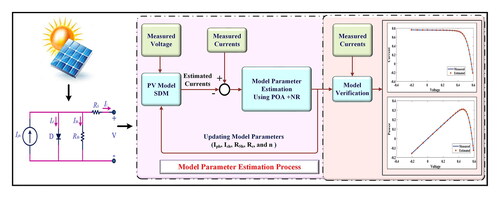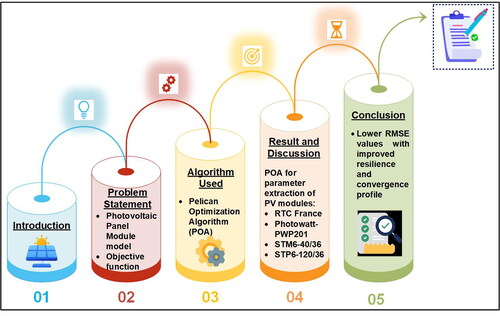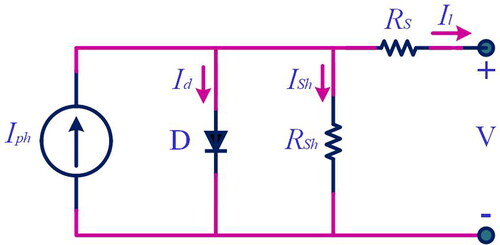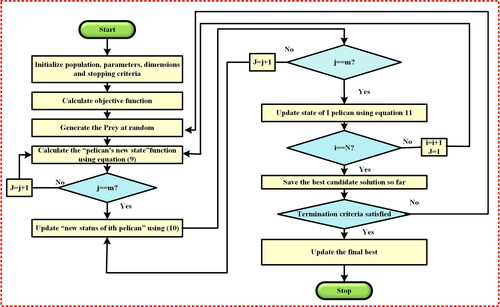 ?Mathematical formulae have been encoded as MathML and are displayed in this HTML version using MathJax in order to improve their display. Uncheck the box to turn MathJax off. This feature requires Javascript. Click on a formula to zoom.
?Mathematical formulae have been encoded as MathML and are displayed in this HTML version using MathJax in order to improve their display. Uncheck the box to turn MathJax off. This feature requires Javascript. Click on a formula to zoom.Abstract
In order to optimize the performance of a Solar Photovoltaic (PV) system, it is necessary to develop an appropriate PV cell model and accurately determine the unknown parameters associated with the model. The process of extracting parameters for PV models is a complex optimization issue that involves nonlinearity and multiple models. Accurate estimation of the characteristics of PV units is crucial since these factors significantly affect the performance of PV systems in terms of power and current generation. Consequently, this research presents an advanced methodology, known as the Pelican Optimization Algorithm (POA), aimed to find the optimal values for the unspecified parameters of PV units. In this study, the Single Diode Model (SDM) is employed to analyze four datasets like RTC France, Photowatt-PWP201, STP-120/36, as well as STM6-40/36 PV panels. The POA algorithm is utilized to determine the unknown parameters of solar PV modules. Furthermore, to enhance the precision of the obtained solutions, this study incorporates the Newton–Raphson (NR) method into the POA algorithm. The POA achieves the optimum Root Mean Square Error (RMSE) values for the four PV models (RTC France, Photowatt-PWP201, STM6-40/36 and STP6-120/36) and the values are found to be 7.7298E-04, 2.0528E-03, 1.7220E-03 and 1.4458E-02 respectively. From the results, it is observed that, POA exhibit superior performance compared to the other MH optimization algorithms. Furthermore, the statistical findings show that the POA algorithm has a higher average robustness and accuracy than the other algorithms.
Reviewing Editor:
1. Introduction
The significant expansion of industries, increasing populations and continuous increase in per capita power consumption result in a constant rise in the power requirements of any nation. It is worth mentioning that electricity accounts for the majority of energy requirements. In addition, owing to rising environmental issues and finite resources, the usage of fossil fuel-based energy production has achieved saturation levels (Østergaard et al., Citation2023; Sharma, Reddy Salkuti, et al., Citation2022). As a result, Renewable Energy Sources (RES) will be required to fill the gap between supply and demand in the future (Madeti & Singh, Citation2017; Rathod & Subramanian, Citation2022). Solar energy has emerged as a practical and feasible RES. Solar power has consistently received the largest portion of investment opportunities in RESs over the last eight years. Due to the significant capital costs of PV-generating installations, it is vital to predict the performance of the PV system from the design stage onwards in order to ensure efficient solar energy usage in energy production (Coello et al., Citation2007; Khanna & Das, Citation2018). With the presence of widespread use and non-polluting nature, solar energy is also regarded as a highly competent renewable resource (Chen, Yu, et al., Citation2016). Single-diode, double-diode equivalent circuit models are now the most widely utilized PV models for describing the I–V characteristics of PV cells. Other PV module models are also incorporated for testing depending on the situation (Jordehi, Citation2016; Lun et al., Citation2014).
The I–V curve is a macro representation of the PV cell that reflects the output characteristics relationship of the cell. Nevertheless, the PV cell’s intrinsic features are reflected in the analogous circuit model. A range of external environmental conditions such as temperature, and radiation intensity are having significant impact on PV power output. Consequently, it is necessary to optimise the use of solar energy, and the accurate application of PV models is crucial. In order to enhance the optimization of solar systems using existing PV models, it is essential to improve the overall dependability of model parameter extraction. As a result, efficient and precise methods for extracting different parameters of these models are required (Xiong et al., Citation2021; Yu et al., Citation2022). The research in recent times has presented a variety of approaches for extracting the parameters. However, most of these methods exhibit limitations either in terms of operational complexity and accuracy or in terms of convergence and speed. There are three types of methods which are most important in the context of solar PV like as analytical, numerical and Metaheuristic (MH) approaches (Gnetchejo et al., Citation2019). The detailed overview of these analytical, numerical and MH methods for determining the parameter of Single Diode Model (SDM) of solar PV is given in .
Table 1. An overview of the several methods for determining all the parameters of a PV cell/module/panel.
To compute the parameters of the solar cell, a series of transcendental equations is solved using the analytical approach. The analytical method’s key benefit is its speed of calculation as well as reasonably accurate outcomes. Analytical procedures are straightforward and take a small amount of time to compute. In certain cases, a single repetition is enough to get the desired outcome (Jacob et al., Citation2015). There are certain problems associated with the analytical process. Analytical algorithms have restricted applicability because of the persistence, distinctiveness, as well as roundness of their objective functions. These algorithms frequently become influenced by the starting solution and tend to converge towards local optima. The most significant issues reported are the characteristic equation’s non-linearity, its parametric ideality factor as well as saturation current. The said factors are usually affected by solar irradiation and temperature. The other problem is the requirement for manufacturer’s data, particularly the maximum power point, short circuit current, as well as open circuit voltage. As a consequence, these procedures and parameters are frequently imprecise. In the majority of situations, the lack of proper data produces disappointing outcomes (Saadaoui et al., Citation2021). On the other hand, numerical approaches are not confined to specific data points. Thus they take into consideration all of the recorded current–voltage (I–V) data for addressing the shortcomings of analytical techniques (Li et al., Citation2023). These statistics indicate the relationship between the Photovoltaic (PV) model’s real input and output thereby allowing it to achieve a better level of confidence. Deterministic and MH approaches are among the largely used numerical methods for practical scenarios. Methods like Newton’s approach (Li et al., Citation2013), Newton–Raphson (NR) method (Chan et al., Citation1986), iterative curve fitting (Elbaset et al., Citation2014) and other deterministic approaches are critical examples.
Even though numerical approaches produce strong results, one of the key problems of several of these algorithms is their reliance on parameter starting values, which might limit the algorithm’s accuracy and convergence. MH algorithms have acquired a lot of interest as a way to solve the limitations of analytical and iterative approaches. The solar module parameter estimate problem is turned into an optimization problem using MH approaches (Saadaoui et al., Citation2021). MH algorithms are global optimization approaches that don’t place any constraints on the issue formulation in addition they can tackle a wide range of complicated problems (Li et al., Citation2022; Long et al., Citation2020). The resultant of such an optimization is complicated since it is nonlinear, bounded and continuous. However, they are successful in offering solutions for a variety of meteorological circumstances. Also in the presence of local optimal spots, they may have convergence issues (Niu et al., Citation2014). The parameters of PV models have been extracted using different kinds of MH approaches and variations. These MH algorithms produced good results for the extraction of PV model parameters when compared to analytical and numerical techniques.
Several MH algorithms can be employed to address real-world engineering design challenges like Ant Lion Optimizer (ALO) (Mirjalili, Citation2015), African Vultures Optimization Algorithm (AVOA) (Abdollahzadeh et al., Citation2021a), Bald Eagle Search (BES) (Alsattar et al., Citation2020), Grey Wolf Optimizer (GWO) (Mirjalili et al., Citation2014), Gorilla Troops Optimizer (GTO) (Abdollahzadeh et al., Citation2021b), Whale Optimization Algorithm (WOA) (Mirjalili & Lewis, Citation2016), Heap-Based Optimizer (HBO) (AbdElminaam et al., Citation2022), Bonobo Optimizer (BO) (Sharma & Raju, Citation2023a, Citation2023b), Memory-based Improved Gorilla Troops Optimizer (MIGTO) (Abdel-Basset et al., Citation2022), Ali Baba and Forty Thieves (AFT) (Sharma, Thangavel, et al., Citation2022), Chaotic Asexual Reproduction Optimization (CARO) (Yuan et al., Citation2015), Comprehensive Learning Rao-1 (CLRao-1) (Ridha et al., Citation2022) and so on. Also, African Vulture Optimization Algorithm (AVOA) (Diab et al., Citation2022), Hybrid Seagull Optimization Algorithm (HSOA) (Long et al., Citation2022), Multiple Learning Backtracking Search Algorithm (MLBSA) (Yu et al., Citation2018) and Classified Perturbation Mutation based Particle Swarm Optimization (CPMPSO) (Liang et al., Citation2020) are recently employed for power systems research in solar energy. Algorithms like Rao-2 (Premkumar et al., Citation2020), Improved Marine Predators Algorithm (IMPA) (Abdel-Basset et al., Citation2021), HBA-OBL (Koç et al., Citation2023), Honey Badger Algorithms (HBA) (Düzenli̇ et al., Citation2022), Chaotic HBA (Düzenli̇ et al., Citation2022) and Rao-3 (Premkumar et al., Citation2020) are also recently reported for solar parameter estimation. Social Network Search Algorithm (SNSA) (Shaheen, Elsayed, et al., Citation2022), Archimedes Optimization Algorithm (AOA) (Krishnan et al., Citation2023), Supply Demand Optimization (SDO) (Ginidi et al., Citation2021), Pattern Search (PS) (AlHajri et al., Citation2012), DE (Xiong et al., Citation2021), Improved Artificial Bee Colony algorithm (IABC) (Wang et al., Citation2015), Chaotic Improved Artificial Bee Colony (CIABC) (Oliva et al., Citation2017), Chaotic HBA (Düzenli̇ et al., Citation2022), Enhanced Social Network Search Algorithm (ESNSA) (Shaheen, Elsayed, et al., Citation2022) and Gaining-Sharing Knowledge based algorithm (GSK) (Xiong et al., Citation2021) are also applied in many works.
Algorithms like Improved Cuckoo Search Algorithm (ImCSA) (Kang et al., Citation2018), Teaching-Learning-based Artificial Bee Colony (TLABC) (Duman et al., Citation2022), Improved Teaching-Learning-Based Optimization (ITLBO) (Li et al., Citation2019), Generalized Oppositional Teaching Learning Based Optimization (GOTLBO) (Chen, Yu, et al., Citation2016), improved adaptive differential evolution with crossover rate repairing technique (R-cr-IJADE) (Gong & Cai, Citation2013), Ranking Teaching-Learning Based algorithm (RTLBO) (Xiong et al., Citation2018), Rao-3 (Premkumar et al., Citation2020), Improved AOA (IAOA) (Krishnan et al., Citation2023), Harmony Search-based Algorithm (HS) (Askarzadeh & Rezazadeh, Citation2012), Hybrid Flower Grey Differential (HFGD) (Sharma et al., Citation2023), CLRao-1 algorithm (Farah et al., Citation2022) and Hybrid Adaptive Nelder-Mead Simplex Algorithm based on Eagle Strategy (EHA-NMS) (Chen, Wu, et al., Citation2016) are of utmost important in parameters extraction. Several enhanced solution strategies based on MH algorithms have been proposed by researchers. However, it is also important to explore further novel MH algorithms. Moreover, the widely recognized no-free lunch theorem posits that each solution technique for an optimization problem possesses the possibility for enhancement and advancement. It is imperative to employ novel optimization methodologies in order to ascertain the parameter estimation of solar PV systems.
Swarm intelligence algorithms include a vast collection of nature-inspired MH techniques that address complicated optimisation issues that are challenging or even infeasible to solve using precise mathematics or classical methodologies. In the aforementioned analysis, the present research work employs a novel and efficient MH algorithm (Pelican Optimization Algorithm [POA]) to estimate the parameters of the PV model. Pavel Trojovsky and Mohammad Dehghani proposed the POA algorithm which draws inspiration from the social behaviour and hunting strategies exhibited by pelicans (Trojovský & Dehghani, Citation2022). The primary advantages of this algorithm are the self-adaptive as well as the flexible nature of its controlling parameters. In order to assess the efficacy of the algorithm in regulating the parameters of SDM, experimental datasets are examined, which have been obtained by measuring under different environmental circumstances including solar radiation and temperature values. Furthermore, a study of the performance of the POA algorithm is conducted through a comparative analysis with other MH algorithms. This evaluation is carried out on parameter identification problems using different PV models. Multiple practical studies as well as analyses provide evidence that the POA algorithm exhibits an excellent degree of computational efficiency, together with notable advantages in terms of accuracy and dependability. The utilization of the POA with NR method for the extraction of solar PV characteristics is being employed for the first time. The primary contributions of this study are as given below.
A new MH algorithm called the Pelican Optimization Algorithm (POA) is utilized to tackle the parameter extraction problem of the solar PV model.
The POA algorithm is utilized to address four distinct PV parameters estimation problems like as RTC France PV panel, Photowatt-PWP201 PV panel, STP-120/36 PV panel, as well as STM6-40/36 PV panel.
The outcomes of POA algorithm have been compared with ALO (Mirjalili, Citation2015), AVOA (Abdollahzadeh et al., Citation2021a), BES (Alsattar et al., Citation2020), GWO (Mirjalili et al., Citation2014), GTO (Abdollahzadeh et al., Citation2021b), WOA (Mirjalili & Lewis, Citation2016) and other parameter estimation techniques presented in the literature.
The findings indicate that the POA algorithm shows the lowest variation in the measured and the calculated values.
The succeeding sections of the paper are organized in the following manner. Section 2 presents an overview of the problem statement and objective function associated with several models pertaining to cells, modules, and PV systems. Section 3 provides a comprehensive depiction of the optimization approach used for this study. Section 4 presents the findings and further analysis or discussion. Finally, a few definitive outcomes and remarks are presented in the last section of the paper. depicts the detailed framework of the proposed study.
2. Photovoltaic panel module model
Various identical circuits have been established by researchers to illustrate the I–V characteristics of PV modules. The SDM is considered to be the most widely used PV equivalent circuit model. The SDM method is known for its simplicity and high level of accuracy (Ben Messaoud, Citation2020). Single-diode parallel circuits are used in PV solar cells to produce parallel circuits. Equivalent circuit models are utilized in solar cells for depicting the relationship or correlation among voltage and current. depicts the PV module’s circuit. The popularity of SDM in the field of solar cell analysis may be attributed to its high level of accuracy and simplicity. Researchers in the field have recognized SDM as a viable tool for identifying the fundamental needs of PV models. The electric current is directed towards a diode. In order to determine the output current, the following calculation is employed (Naeijian et al., Citation2021).
(1)
(1)
In the given context, Iph denotes the current produced by the photo generation process, while Id represents the current flowing through the diode, which can be determined by employing EquationEquation (2)(2)
(2) . Additionally, Ish signifies the current passing through the shunt resistor, which can be computed using EquationEquation (3)
(3)
(3) . Finally, Il denotes the ultimate value of the current which is calculated by utilizing the Shockley equation.
(2)
(2)
(3)
(3)
Additionally, the I–V relationship at the PV panel module’s output terminal is written as follows (Askarzadeh, A., & dos Santos Coelho, Citation2015; Chin et al., Citation2015; Sharma & Raju, Citation2023a, Citation2023b).
(4)
(4)
where q is the charge of an electron (1.6021764E-19(C)), K indicates Boltzmann constant (1.3805E-23(J/K)), T denotes the temperature, the symbol n denotes the ideality factor or constant of the diode, Isd symbolizes the reverse saturated current, Rs denotes the series resistance, whereas Rsh signifies the shunt resistance. The concept of series resistance refers to the total resistance encountered in an electrical circuit when resistors are connected in a series configuration. The electrical resistance (Rs) of a PV system encompasses several components, including the emitter, base, metal contact resistance, as well as semiconductor-metal contact resistance. These resistances play a significant role in determining the fill factor of the system. The parameters of PV modules like Iph, Isd, Rs, Rsh and n must be extracted using the optimization algorithm. These parameters are almost similar to the ones used in the proposed SDM model.
2.1. Objective function
The optimization of unknown parameters for the SDM model is to minimize the error among experimental as well as calculated values while analysing the characteristics of PV cells. In order to determine the optimal parameters for all variables in the PV model, an objective function known as the RMSE can be developed. As a result, to approach or closely fit to the practical value, the RMSE between the observed and estimated currents is shown in EquationEquation (5)(5)
(5) (Ben Messaoud, Citation2020; Shaheen, El-Seheimy, et al., Citation2022). Also, the Individual Absolute Error (IAE) for current as well as power are calculated by using EquationEquations (6)
(6)
(6) and Equation(7)
(7)
(7) .
(5)
(5)
(6)
(6)
(7)
(7)
where Im represents the measured current, Ie indicates the estimated current, Pm denotes the power that is measured, Pe signifies the power that is calculated and N refers the number of samples.
3. Pelican Optimization Algorithm
The POA is a population-based optimization technique that employs pelicans as active participants. Each population member represents a possible solution in population-based algorithms. The population members suggest values for the optimization problem variables based on their respective locations in the search space. Population members are initialized randomly inside the lower as well as higher boundaries of the problem which are specified by EquationEquation (8)(8)
(8) .
(8)
(8)
where
and
the value of the jth variable as provided by the ith candidate solution is denoted as
n is the total number of individuals in the population, whereas the variable m denotes the number of variables associated with the challenges or problems. The variable rand denotes a random integer inside the interval [0, 1]. The variables jth lower bound and jth upper bound refer to the lower and upper bounds respectively.
In order to enhance the efficacy of the optimization solution, the POA emulates the behavioural and strategic patterns exhibited by pelicans during their search and capture of prey. In two steps this hunting method is simulated and is best described as approaching prey (exploration stage) and the water’s surface winging (exploitation stage).
3.1. Phase 1: Moving or transitioning towards prey (exploration stage)
The pelicans detect the position of the prey in the first phase and then travel towards that place. The POA is expected to improve the exploratory capabilities by including the modelling of the pelican’s search approach, hence enabling the discovery of different areas within the search space. One essential element of the POA is the stochastic generation of the prey’s location inside the search space. The exploratory capability of POA is enhanced when used in the targeted search inside the problem-solving domain. The above concepts, together with the pelican’s predatory strategy, are mathematically expressed in EquationEquation (9)(9)
(9) .
(9)
(9)
where
is the ith pelican’s new state in the jth dimension based on phase 1,
is the prey’s position in the jth dimension and
is its objective function’s value. The variable I is a numerical parameter which can assume a random value of either 1 or 2. The selection of this parameter is randomized for every iteration and specific to the selection. When this parameter’s value is equal to two, it causes a member’s displacement to increase, perhaps leading to additional regions of the search domain. The parameter I has a significant influence on the ability of the POA to precisely analyse the search area.
The POA approves the new location of a pelican only if the value of the objective function demonstrates a clear improvement at that specific the location. Efficient updating is essential in ensuring that the algorithm does not transition to suboptimal locations while updating a mechanism. The following EquationEquation (10)(10)
(10) is employed to represent new status without moving to suboptimal locations.
(10)
(10)
where
is the ith pelican’s new status, and
is its phase 1 objective function value. Now phase 2 is described in the subsequent section.
3.2. Winging on the water surface (exploitation phase)
The pelicans expand their wings to pull or lift the fish higher once they reach the water’s surface. After catching the fish, the collected prey is moved to the neck pouch. Pelicans use this strategy to capture a greater quantity of fish in the targeted area. After analysing the activity of pelicans, the POA gradually reaches more optimal positions inside the hunting area. This technique improves POA’s local search and exploitation capabilities. In order to achieve a more accurate solution, the algorithm must analyze the points in the close vicinity of the pelican’s position from a mathematical perspective. The following EquationEquation (11)(11)
(11) mathematically simulates pelican behaviour when hunting.
(11)
(11)
where
denotes the updated state of the ith pelican in the jth dimension during phase 2. A constant called R has a value of 0.2. The neighbourhood radius of xi,j is represented by R*(1 − t/T), where t corresponds to the iteration counter and also T represents the highest iteration number. The coefficient denoted as ‘R·(1 − t/T)’ signifies the radius of the neighbourhood around the population members. The neighbourhood is defined wherein a local search to facilitate convergence towards an improved solution. The aforementioned parameter or coefficient plays a significant role in enhancing the exploitation capacity of the POA thereby facilitating its convergence towards the optimal global solution. During the early iterations, the coefficient exhibits a substantial or large value leading to the inclusion of a bigger region surrounding each member. As the POA algorithm proceeds the coefficient ‘R (1 − t/T)’ declines which results in a reduction in the radii of the neighbourhoods associated with each member. This methodology enables the examination of the vicinity of every individual within the population. The search is carried out through finer or smaller steps with more precise increments. Consequently, the process of POA easily approaches solutions which are in closer proximity to the global optimum. In some cases, it even attains the exact global optimum as per the requirement of the proposed methodology.
During the stage of search, the process of efficient updating has been employed for accepting or rejecting the new pelican location as represented by EquationEquation (12)(12)
(12) .
(12)
(12)
where the updated status of the ith pelican is represented as
while its associated objective function value is represented as
are determined based on the second stage. Algorithm 1 illustrates various stages of the POA together with its corresponding pseudo-code (Trojovský & Dehghani, Citation2022) is presented in Algorithm 1. Also, the flowchart for POA algorithm is presented in .
Algorithm 1.
POA pseudo-code
Start
Provide the details of the optimisation problem.
Determine the POA's population size (N) number of iterations (T)
Initialization of pelican’s location and computation of the objective function.
For t = 1:T
Randomly produce the prey's location.
For I = 1:N
Phase 1: Approaching the prey (stage of exploration).
For j = 1:m
Utilising EquationEquation (9)
(9)
(9) , find out the new status of the jth dimension.
End
By utilizing Equationequation (10)
(10)
(10) , modify the ith individual in the population.
Phase 2: Winging on the water surface (stage of exploitation).
For j = 1:m.
Utilising EquationEquation (11)
(11)
(11) compute the updated state of the jth dimension.
End
Use EquationEquation (12)
(12)
(12) to update the ith population member.
End
Update the optimal candidate solution.
End
Output optimal or best candidate
End
4. Results and discussion
The POA is used to evaluate the effectiveness of solving the PV model parameter estimation in the RTC France, Photowatt-PWP201, STM6-40/36 and STP6-120/36 PV modules. The RTC France, Photowatt-PWP201, STM6-40/36 and STP6-120/36 PV modules parameters are extracted using the POA technique. The outcomes of POA algorithm have been compared with ALO (Mirjalili, Citation2015), AVOA (Abdollahzadeh et al., Citation2021a), BES (Alsattar et al., Citation2020), GWO (Mirjalili et al., Citation2014), GTO (Abdollahzadeh et al., Citation2021b), WOA (Mirjalili & Lewis, Citation2016) and other parameter estimate techniques presented in the literature. In order to achieve optimal performance, all of the parameters have been configured to match the values specified in the original publications. presents the lower and upper boundaries for various PV modules. The overall obtained results of RTC France, Photowatt-PWP201, STM6-40/36 and STP6-120/36 PV modules which is calculated by the POA algorithm are presented in . In addition, for fair comparison, the maximum number of iteration and population size is set to be 700 and 50. Every algorithm runs 30 trials independently. This study implements the proposed POA approach along with other comparative MH algorithms utilizing MATLAB: 2021 on the VivoBook_Asus model which is equipped with an Intel Core i5 CPU (Intel(R) Core(TM) i5-1035G1), 8GB of RAM, and the Windows 11 Ultimate operating system.
Table 2. The range of variables or parameters in the PV model.
Table 3. Results of different PV Modules obtained using POA.
4.1. Single Diode Model (RTC France)
In this PV panel, an SDM has been employed to determine the five parameters of a commercially manufactured silicon PV cell produced by RTC France. The PV cell was tested under working conditions with a temperature of 33 °C as well as solar irradiation of 1000 W/m2. presents the measured as well as calculated data points for current and voltage. The lowest value of IAE for current and power are obtained to be 0.017639233 and 0.006484, respectively. In , the values are extracted using MH optimization for better analysis and comparison with the POA algorithm. It is observed that the parameter values obtained using MH exhibit large variations when it is applied to RTC France. The estimated current derived by this technique has a good degree of match with the observed current as demonstrated and it is producing low IAE which is presented in . The comparison of the RMSE results and extracted parameters for the RTC France of the POA algorithm with different algorithms is given in . The lowest RMSE value obtained by using POA is 7.7298E-04. The I–V as well as P–V characteristic curves, derived using the optimal values of the POA algorithm, are displayed in . The curves demonstrate an excellent match between the observed and simulated data. Also, displays the convergence curves of all algorithms on RTC France. It is found that, the POA demonstrates rapid convergence to the minimum value when compared to other algorithms.
Figure 4. The measured and calculated curves’ characteristics of SDM: (a) V–I curve, (b) V–P curve and (c) convergence characteristics.
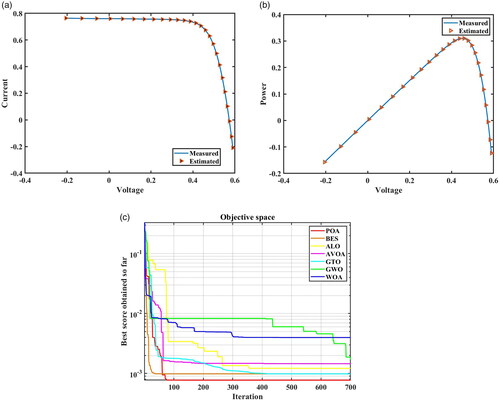
Table 4. The results of POA's computed current and absolute error for a SDM.
Table 5. Comparison of POA results with other MH optimization methods in RTC literature (SDM).
4.2. POA for parameter extraction of Photowatt-PWP201 PV module
The POA algorithm’s performance for Photowatt-PWP201 PV module is discussed in this section. The module is tested with 25 different combinations of I–V values as per standard. The sample is maintained at a temperature of 24 °C and an irradiation level of 360 W/m2 (Mostafa et al., Citation2020). The measured data points (I–V) and the calculated values of current and voltage for these points using the POA algorithm in Photowatt-PWP201 PV Module are given in . It is worth observing that the lowest error value (IAE current) observed in this analysis is 0.04253. Similarly, the IAE of the power achieved is 0.452538. The comparison of the RMSE results and extracted parameters for the Photowatt-PW201 module of the POA algorithm with other MH algorithms is demonstrated in . Also, the RMSE value achieved by the Photowatt-PWP201 PV module by using POA algorithm is 2.0528E-03, indicating its superior performance which is illustrated in . The I–V curve, P–V curve, as well as convergence curve is plotted for Photowatt-PWP201 PV module for ease of understanding and comparison. The calculated as well as experimental I–V, P–V and convergence characteristic curves for Photowatt-PWP201 PV module are shown in . The curves present a better match between the observed and simulated data. The calculated parameters correspond well with the measured ones demonstrating the POA’s efficiency.
Figure 5. The measured and calculated curves’ characteristics of Photowatt-PWP201 PV module: (a) V–I curve, (b) P–V curve and (c) convergence curve.
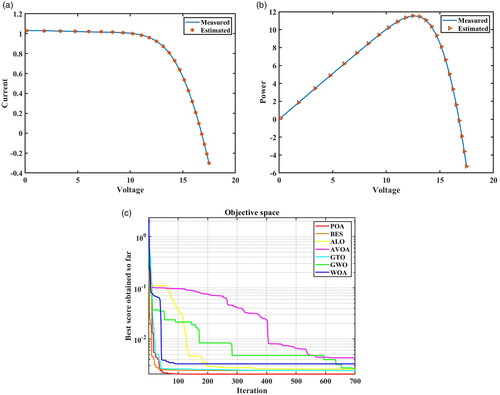
Table 6. The results of POA’s computed current and absolute error for a Photowatt-PWP201 PV module.
Table 7. Comparison of POA results with other MH optimization techniques in Photowatt-PWP201 PV module.
4.3. POA for parameter extraction of STM6-40/36 PV module
The efficacy of the POA algorithm has been established by the computation of the optimum parameter for STM6-40/36. Under standard temperature conditions, the characteristics of the STM6-40/36 PV module were computed. The experiment in this model consists of 20 different combinations of I–V measured samples, as reported in reference (Yuan et al., Citation2015). These samples were extracted at a temperature of 51 °C and at an irradiance of 1000 W/m2. The PV panel consists of 36 PV cells, namely monocrystalline silicon, which is interconnected in a series configuration. The measured data points (I–V) and estimated points using the POA in the STM6-40/36 PV module, as well as error (IAE) are given in . The lowest IAE for current is obtained to be 0.021863 value and it is important to note that the lowest IAE (power) achieved is 0.034625. The most optimal value of RMSE is 1.7220E-03 which is shown in . The I–V as well as P–V, characteristics curves are drawn in for this case and it clearly shows that the measured and experimental I–V and P–V curve are perfectly matching. Furthermore, illustrates the convergence characteristics of all algorithms for STM6-40/36 PV module.
Figure 6. The measured and calculated curves’ characteristics of STM6-40/36 PV module: (a) V–I curve, (b) V–P curve and (c) convergence curve.
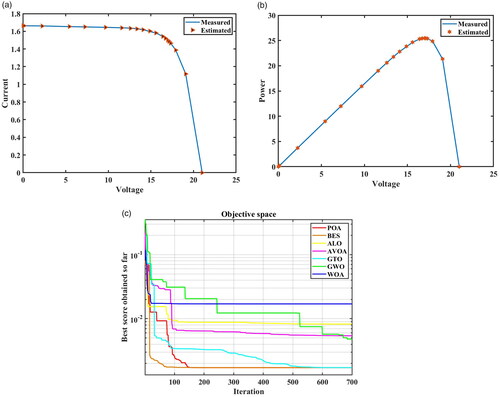
Table 8. The results of POA's computed current and absolute error for a STM6-40/36 PV module.
Table 9. Comparison of POA results with other MH optimization techniques in STM6-40/36 PV Module.
4.4. POA for parameter extraction of STP6-120/36 module
In the fourth case, the POA has been verified by the computation of the optimum parameters for STP6-120/36 PV module. The sample used in the module consists of 24 distinct combinations of I–V points (Abdel-Basset et al., Citation2021). As like in the other three cases, the extraction of the sample has been conducted under standard operating conditions, namely at a temperature of 55 °C as well as at a solar irradiation of 1000 W/m2. The PV panel consists of a series connection of 36 PV cells made of polycrystalline silicon. The data presented in obtained for this model illustrate the measured data points (I–V) and the estimated value for these points employing the POA in the STP6-120/36 PV module. As expected the corresponding error (IAE) of POA is much less and it comes out to be 0.272222. Furthermore, presents the best IAE (power) and it is found to be 3.886659. The comparison of the RMSE outcomes for the STP6-120/36 module of the proposed POA with other different algorithms from the literature is given in . Also, the RMSE of the SDM achieves a value of 1.4458E-02, indicating POA’s superior performance. The measured and calculated I–V as well as P–V characteristic curves along with the convergence profile curve are displayed in for this module. It is found that, the POA algorithm demonstrates fastest convergence to the minimum value when compared to other algorithms.
Figure 7. The measured and computed curves’ characteristics of STP6-120/36 module: (a) V–I curve (b) V–P curve and (c) convergence curve.
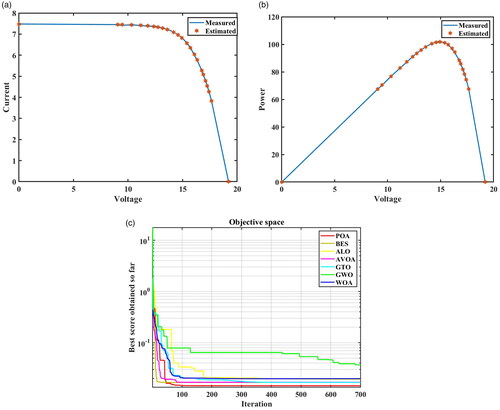
Table 10. The results of POA's computed current and absolute error for a STP6-120/36 module.
Table 11. Comparison of POA results with other MH optimization techniques in STP6-120/36 module.
5. Conclusion
This article presented the implementation of an optimization approach known as the POA algorithm for the extraction of unknown parameters in PV modules. Specifically, the algorithm focuses on estimating the SDM parameters, including Iph, Ish, RSh, Rs and n. This work examined the effectiveness of the POA algorithm by analyzing datasets of four different PV modules, namely RTC France, Photowatt-PWP201, STM6-40/36 and STP6-120/36 PV modules. This article offered a discussion on statistical errors by specifically focusing on the IAE and the RMSE. The outcomes obtained by POA algorithm have been compared with ALO, AVOA, BES, GWO, GTO, WOA and other MH algorithms stated in the literature. The experimental findings illustrates that the POA algorithm shows better competitive search capabilities and superior dependability as compared to existing MH algorithms. The obtained results clearly demonstrates that the POA algorithm effectively reaches a favourable equilibrium between the I–V as well as P–V characteristics of both the measured as well as calculated data. Therefore, it is essential to consider this algorithm as a viable alternative for addressing the challenges associated with the parameter identification in the PV model. One of the possible future directions to this research is that the fundamental POA algorithm can be modified by applying self-adapting techniques to increase its reliability in PV parameter estimation and MPPT problems.
Author’s contribution statement
Asmita Ajay Rathod: Writing – review & editing, Writing – original draft, Validation, Software, Conceptualization, Methodology, Data curation. Balaji Subramanian: Writing – review & editing, Validation, Supervision, Project administration, Conceptualization.
Acknowledgements
Authors would like to thank Vellore Institute of Technology, Vellore for providing required support for this publication.
Disclosure Statement
No potential conflict of interest was reported by the authors.
Data availability statement
All the necessary data pertaining to the simulations has been included in the manuscript in the form of tables and figures. Additional information will be provided on request.
Additional information
Funding
Notes on contributors

Asmita Ajay Rathod
Asmita Ajay Rathod received the B.E. degree in Electrical, Electronics and Power Engineering from Sant Gadge Baba Amravati University, Amravati, Maharashtra, India, in 2017, and M.Tech. degree in Electrical Power System from Shivaji University, Kolhapur, Maharashtra, India, in 2019. She is currently pursuing the Ph.D. degree in the School of Electrical Engineering, Vellore Institute of Technology, Vellore, India. Her research interests include the Solar PV, Fuel Cell and Modeling, Energy Management in Renewable Energy Integrated Microgrid, Metaheuristic Optimization Techniques.

Balaji Subramanian
Dr. S. Balaji received Master of Technology from National Institute of Technology, Tiruchirappalli, and Ph.D. in Electrical Engineering from VIT University, Vellore, India. Currently he is working as Associate Professor in the School of Electrical Engineering (SELECT), VIT University, India. He is a recipient of research awards for his contribution to research from VIT University. He has published more than 40 research papers in the area of Electrical Communication Engineering, Optimization and other related areas in International Journals and Conferences. His areas of Research include Internet of Things, Hybrid Energy Systems, Optimization and Wireless Communication.
References
- Abdel-Basset, M., El-Shaha't, D., Chakrabortty, R. K., & Ryan, M. (2021). Parameter estimation of photovoltaic models using an improved marine predators algorithm. Energy Conversion and Management, 227, 113491. https://doi.org/10.1016/j.enconman.2020.113491
- Abdel-Basset, M., El-Shahat, D., Sallam, K. M., & Munasinghe, K. (2022). Parameter extraction of photovoltaic models using a memory-based improved gorilla troops optimizer. Energy Conversion and Management, 252, 115134. https://doi.org/10.1016/j.enconman.2021.115134
- AbdElminaam, D. S., Houssein, E. H., Said, M., Oliva, D., & Nabil, A. (2022). An efficient heap-based optimizer for parameters identification of modified photovoltaic models. Ain Shams Engineering Journal, 13(5), 101728. https://doi.org/10.1016/j.asej.2022.101728
- Abdollahzadeh, B., Gharehchopogh, F. S., & Mirjalili, S. (2021a). African vultures optimization algorithm: A new nature-inspired metaheuristic algorithm for global optimization problems. Computers and Industrial Engineering, 158, 107408. https://doi.org/10.1016/j.cie.2021.107408
- Abdollahzadeh, B., Gharehchopogh, F. S., & Mirjalili, S. (2021b). Artificial gorilla troops optimizer: A new nature‐inspired metaheuristic algorithm for global optimization problems. International Journal of Intelligent Systems, 36(10), 5887–5958. https://doi.org/10.1002/int.22535
- AlHajri, M. F., El-Naggar, K. M., AlRashidi, M. R., & Al-Othman, A. K. (2012). Optimal extraction of solar cell parameters using pattern search. Renewable Energy, 44, 238–245. https://doi.org/10.1016/j.renene.2012.01.082
- Alsattar, H. A., Zaidan, A. A., & Zaidan, B. B. (2020). Novel meta-heuristic bald eagle search optimisation algorithm. Artificial Intelligence Review, 53(3), 2237–2264. https://doi.org/10.1007/s10462-019-09732-5
- Aribia, H. B., El-Rifaie, A. M., Tolba, M. A., Shaheen, A., Moustafa, G., Elsayed, F., & Elshahed, M. (2023). Growth optimizer for parameter identification of solar photovoltaic cells and modules. Sustainability, 15(10), 7896. https://doi.org/10.3390/su15107896
- Askarzadeh, A., & dos Santos Coelho, L. (2015). Determination of photovoltaic modules parameters at different operating conditions using a novel bird mating optimizer approach. Energy Convers. Manag, 89, 608–614. https://doi.org/10.1016/j.enconman.2014.10.025
- Askarzadeh, A., & Rezazadeh, A. (2012). Parameter identification for solar cell models using harmony search-based algorithms. Solar Energy, 86(11), 3241–3249. https://doi.org/10.1016/j.solener.2012.08.018
- Ben Messaoud, R. (2020). Extraction of uncertain parameters of double-diode model of a photovoltaic panel using Ant Lion Optimization. SN Applied Sciences, 2(2), 239. https://doi.org/10.1007/s42452-020-2013-z
- Beşkirli, A., & Dağ, İ. (2022). An efficient tree seed inspired algorithm for parameter estimation of Photovoltaic models. Energy Reports, 8, 291–298. https://doi.org/10.1016/j.egyr.2021.11.103
- Beşkirli, A., & Dağ, İ. (2023). I-CPA: An improved carnivorous plant algorithm for solar photovoltaic parameter identification problem. Biomimetics, 8(8), 569. https://doi.org/10.3390/biomimetics8080569
- Chan, D. S. H., Phillips, J. R., & Phang, J. C. H. (1986). A comparative study of extraction methods for solar cell model parameters. Solid State Electronics, 29(3), 329–337. https://doi.org/10.1016/0038-1101(86)90212-1
- Chen, Z., Wu, L., Lin, P., Wu, Y., & Cheng, S. (2016). Parameters identification of photovoltaic models using hybrid adaptive Nelder-Mead simplex algorithm based on eagle strategy. Applied Energy, 182, 47–57. https://doi.org/10.1016/j.apenergy.2016.08.083
- Chen, X., Yu, K., Du, W., Zhao, W., & Liu, G. (2016). Parameters identification of solar cell models using generalized oppositional teaching learning based optimization. Energy, 99, 170–180. https://doi.org/10.1016/j.energy.2016.01.052
- Chin, V. J., Salam, Z., & Ishaque, K. (2015). Cell modelling and model parameters estimation techniques for photovoltaic simulator application: A review. Applied Energy, 154, 500–519. https://doi.org/10.1016/j.apenergy.2015.05.035
- Coello, C., Veldhuizen, D., & Lamont, G. (2007). Evolutionary algorithms for solving multi-objective problems. Springer US.
- Diab, A. A. Z., Tolba, M. A., El-Rifaie, A. M., & Denis, K. A. (2022). Photovoltaic parameter estimation using honey badger algorithm and African vulture optimization algorithm. Energy Reports, 8, 384–393. https://doi.org/10.1016/j.egyr.2022.05.168
- Duman, S., Kahraman, H. T., Sonmez, Y., Guvenc, U., Kati, M., & Aras, S. (2022). A powerful meta-heuristic search algorithm for solving global optimization and real-world solar photovoltaic parameter estimation problems. Engineering Applications of Artificial Intelligence, 111, 104763. https://doi.org/10.1016/j.engappai.2022.104763
- Düzenli̇, T., Kutlu Onay, F., & Aydemi̇r, S. B. (2022). Improved honey badger algorithms for parameter extraction in photovoltaic models. Optik (Stuttg), 268, 169731. https://doi.org/10.1016/j.ijleo.2022.169731
- Elbaset, A. A., Ali, H., & Abd-El Sattar, M. (2014). Novel seven-parameter model for photovoltaic modules. Solar Energy Materials and Solar Cells, 130, 442–455. https://doi.org/10.1016/j.solmat.2014.07.016
- Elhammoudy, A., Elyaqouti, M., Ben Hmamou, D., Arjdal, E. H., Saadaoui, D., Lidaighbi, S., & Choulli, I. (2023). A novel numerical method for estimation the photovoltaic cells/modules parameters based on dichotomy method. Results in Optics, 12, 100445. https://doi.org/10.1016/j.rio.2023.100445
- El-Sehiemy, R., Shaheen, A., El-Fergany, A., & Ginidi, A. (2023). Electrical parameters extraction of PV modules using artificial hummingbird optimizer. Scientific Reports, 13(1), 9240. https://doi.org/10.1038/s41598-023-36284-0
- Farah, A., Belazi, A., Benabdallah, F., Almalaq, A., Chtourou, M., & Abido, M. A. (2022). Parameter extraction of photovoltaic models using a comprehensive learning Rao-1 algorithm. Energy Conversion and Management, 252, 115057. https://doi.org/10.1016/j.enconman.2021.115057
- Gao, X., Cui, Y., Hu, J., Tahir, N., & Xu, G. (2018). Performance comparison of exponential, Lambert W function and Special Trans function based single diode solar cell models. Energy Conversion and Management, 171, 1822–1842. https://doi.org/10.1016/j.enconman.2018.06.106
- Ginidi, A. R., Shaheen, A. M., El-Sehiemy, R. A., & Elattar, E. (2021). Supply demand optimization algorithm for parameter extraction of various solar cell models. Energy Reports, 7, 5772–5794. https://doi.org/10.1016/j.egyr.2021.08.188
- Gnetchejo, P. J., Ndjakomo Essiane, S., Ele, P., Wamkeue, R., Mbadjoun Wapet, D., & Perabi Ngoffe, S. (2019). Important notes on parameter estimation of solar photovoltaic cellEnergy Conversion and Management, 197, 111870. https://doi.org/10.1016/j.enconman.2019.111870
- Gong, W., & Cai, Z. (2013). Parameter extraction of solar cell models using repaired adaptive differential evolution. Solar Energy, 94, 209–220. https://doi.org/10.1016/j.solener.2013.05.007
- Hali, A., & Khlifi, Y. (2021). Photovoltaic panel parameters determination using two numerical methods. Materials Today: Proceedings, 45, 7377–7382. https://doi.org/10.1016/j.matpr.2021.01.313
- Jacob, B., Balasubramanian, K., Babu T, S., Azharuddin, S. M., & Rajasekar, N. (2015). Solar PV modelling and parameter extraction using artificial immune system. Energy Procedia, 75, 331–336. https://doi.org/10.1016/j.egypro.2015.07.375
- Jordehi, A. R. (2016). Parameter estimation of solar photovoltaic (PV) cells: A review. Renewable and Sustainable Energy Reviews, 61, 354–371. https://doi.org/10.1016/j.rser.2016.03.049
- Kang, T., Yao, J., Jin, M., Yang, S., & Duong, T. (2018). A novel improved cuckoo search algorithm for parameter estimation of photovoltaic (PV) models. Energies, 11(5), 1060. https://doi.org/10.3390/en11051060
- Khanna, V., & Das, B. K. (2018). A method to model the maximum power output of photovoltaic modules using statistical analysis and matlab-simulink simulation; a method to model the maximum power output of photovoltaic modules using statistical analysis and matlab-simulink simulation. International Journal of Engineering Research & Technology, 7(5), 349–358. www.ijert.org.
- Koç, K., Demirtaş, M., & Çetinbaş, İ. (2023). Parameter extraction of photovoltaic models by honey badger algorithm and wild horse optimizer Bal porsuğu algoritması ve vahşi at optimize edici ile fotovoltaik modellerin parametre çıkarımı. Journal of Polytechnic, 26(4), 1453–1465. https://doi.org/10.2339/politeknik.1155696
- Krishnan, H., Islam, M. S., Ahmad, M. A., & Rashid, M. I. M. (2023). Parameter identification of solar cells using improved Archimedes Optimization Algorithm. Optik (Stuttg), 295, 171465. https://doi.org/10.1016/j.ijleo.2023.171465
- Liang, J., Ge, S., Qu, B., Yu, K., Liu, F., Yang, H., Wei, P., & Li, Z. (2020). Classified perturbation mutation based particle swarm optimization algorithm for parameters extraction of photovoltaic models. Energy Conversion and Management, 203, 112138. https://doi.org/10.1016/j.enconman.2019.112138
- Lidaighbi, S., Elyaqouti, M., Assalaou, K., Ben Hmamou, D., Saadaoui, D., & H'roura, J. (2022). Parameter estimation of photovoltaic modules using analytical and numerical/iterative approaches: A comparative study. Materials Today: Proceedings, 52, 1–6. https://doi.org/10.1016/j.matpr.2021.10.021
- Li, S., Gong, W., Yan, X., Hu, C., Bai, D., Wang, L., & Gao, L. (2019). Parameter extraction of photovoltaic models using an improved teaching-learning-based optimization. Energy Conversion and Management, 186, 293–305. https://doi.org/10.1016/j.enconman.2019.02.048
- Li, Y., Huang, W., Huang, H., Hewitt, C., Chen, Y., Fang, G., & Carroll, D. L. (2013). Evaluation of methods to extract parameters from current–voltage characteristics of solar cells. Solar Energy, 90, 51–57. https://doi.org/10.1016/j.solener.2012.12.005
- Li, Z., Hu, J., Han, Y., Li, H., Wang, J., & Lund, P. D. (2023). Parameter identification and generality analysis of photovoltaic module dual-diode model based on artificial hummingbird algorithm. Clean Energy, 7(6), 1219–1232. https://academic.oup.com/ce/article/7/6/1219/7425144. https://doi.org/10.1093/ce/zkad066
- Li, D., Yang, B., Li, L., Li, Q., Deng, J., & Guo, C. (2022). Recent photovoltaic cell parameter identification approaches: A critical note. Frontiers in Energy Research, 10, 1–5. https://doi.org/10.3389/fenrg.2022.902749
- Long, W., Cai, S., Jiao, J., Xu, M., & Wu, T. (2020). A new hybrid algorithm based on grey wolf optimizer and cuckoo search for parameter extraction of solar photovoltaic models. Energy Conversion and Management, 203, 112243. https://doi.org/10.1016/j.enconman.2019.112243
- Long, W., Jiao, J., Liang, X., Xu, M., Tang, M., & Cai, S. (2022). Parameters estimation of photovoltaic models using a novel hybrid seagull optimization algorithm. Energy, 249, 123760 https://doi.org/10.1016/j.energy.2022.123760
- Lun, S., Du, C., Sang, J., Guo, T., Wang, S., & Yang, G. (2014). An improved explicit I – V model of a solar cell based on symbolic function and manufacturer’s datasheet. Solar Energy, 110, 603–614. https://doi.org/10.1016/j.solener.2014.09.032
- Madeti, S. R., & Singh, S. N. (2017). Monitoring system for photovoltaic plants: A review. Renewable and Sustainable Energy Reviews, 67, 1180–1207. https://doi.org/10.1016/j.rser.2016.09.088
- Mares, O., Paulescu, M., & Badescu, V. (2015). A simple but accurate procedure for solving the five-parameter model. Energy Conversion and Management, 105, 139–148. https://doi.org/10.1016/j.enconman.2015.07.046
- Mirjalili, S. (2015). The ant lion optimizer. Advances in Engineering Software, 83, 80–98. https://doi.org/10.1016/j.advengsoft.2015.01.010
- Mirjalili, S., & Lewis, A. (2016). The whale optimization algorithm. Advances in Engineering Software, 95, 51–67. https://doi.org/10.1016/j.advengsoft.2016.01.008
- Mirjalili, S., Mirjalili, S. M., & Lewis, A. (2014). Grey wolf optimizer. Advances in Engineering Software, 69, 46–61. https://doi.org/10.1016/j.advengsoft.2013.12.007
- Mohamed, R., Abdel-Basset, M., Sallam, K. M., Hezam, I. M., Alshamrani, A. M., & Hameed, I. A. (2024). Novel hybrid kepler optimization algorithm for parameter estimation of photovoltaic modules. Scientific Reports, 14(1), 3453. https://doi.org/10.1038/s41598-024-52416-6
- Mostafa, M., Rezk, H., Aly, M., & Ahmed, E. M. (2020). A new strategy based on slime mould algorithm to extract the optimal model parameters of solar PV panel. Sustainable Energy Technologies and Assessments, 42, 100849. https://doi.org/10.1016/j.seta.2020.100849
- Muhammadsharif, F. F. (2022). A new simplified method for efficient extraction of solar cells and modules parameters from datasheet information. Silicon, 14(6), 3059–3067. https://doi.org/10.1007/s12633-021-01097-1
- Naeijian, M., Rahimnejad, A., Ebrahimi, S. M., Pourmousa, N., & Gadsden, S. A. (2021). Parameter estimation of PV solar cells and modules using Whippy Harris Hawks Optimization Algorithm. Energy Reports, 7, 4047–4063. https://doi.org/10.1016/j.egyr.2021.06.085
- Ndegwa, R., Simiyu, J., Ayieta, E., & Odero, N. (2020). A fast and accurate analytical method for parameter determination of a photovoltaic system based on manufacturer’s data. Journal of Renewable Energy, 2020, 1–18. https://doi.org/10.1155/2020/7580279
- Nicaire, N. F., Steve, P. N., Salome, N. E., & Grégroire, A. O. (2021). Parameter estimation of the photovoltaic system using Bald Eagle Search (BES) algorithm. International Journal of Photoenergy, 2021, 1–20. https://doi.org/10.1155/2021/4343203
- Niu, Q., Zhang, H., & Li, K. (2014). An improved TLBO with elite strategy for parameters identification of PEM fuel cell and solar cell models. International Journal of Hydrogen Energy, 39(8), 3837–3854. https://doi.org/10.1016/j.ijhydene.2013.12.110
- Oliva, D., Ewees, A. A., Aziz, M. A. E., Hassanien, A. E., & Peréz-Cisneros, M. (2017). A chaotic improved artificial bee colony for parameter estimation of photovoltaic cells. Energies, 10(7), 865. https://doi.org/10.3390/en10070865
- Østergaard, P. A., Duic, N., Noorollahi, Y., & Kalogirou, S. (2023). Advances in renewable energy for sustainable development. Renewable Energy, 219, 119377. https://doi.org/10.1016/j.renene.2023.119377
- Premkumar, M., Babu, T. S., Umashankar, S., & Sowmya, R. (2020). A new metaphor-less algorithms for the photovoltaic cell parameter estimation. Optik (Stuttg), 208, 164559. https://doi.org/10.1016/j.ijleo.2020.164559
- Rathod, A. A., & Subramanian, B. (2022). Scrutiny of hybrid renewable energy systems for control, power management, optimization and sizing: Challenges and future possibilities. Sustainability, 14(24), 16814. https://doi.org/10.3390/su142416814
- Ridha, H. M., Hizam, H., Mirjalili, S., Othman, M. L., Ya’acob, M. E., & Ahmadipour, M. (2022). Parameter extraction of single, double, and three diodes photovoltaic model based on guaranteed convergence arithmetic optimization algorithm and modified third order Newton Raphson methods. Renewable and Sustainable Energy Reviews, 162, 112436. https://doi.org/10.1016/j.rser.2022.112436
- Saadaoui, D., Elyaqouti, M., Assalaou, K., Ben Hmamou, D., & Lidaighbi, S. (2021). Parameters optimization of solar PV cell/module using genetic algorithm based on non-uniform mutation. Energy Conversion and Management: X, 12, 100129. https://doi.org/10.1016/j.ecmx.2021.100129
- Shaban, H., Houssein, E. H., Pérez-Cisneros, M., Oliva, D., Hassan, A. Y., Ismaeel, A. A. K., AbdElminaam, D. S., Deb, S., & Said, M. (2021). Identification of parameters in photovoltaic models through a Runge Kutta optimizer. Mathematics, 9(18), 2313. https://doi.org/10.3390/math9182313
- Shaheen, A. M., Elsayed, A. M., Ginidi, A. R., El‐Sehiemy, R. A., & Elattar, E. (2022). Enhanced social network search algorithm with powerful exploitation strategy for PV parameters estimation. Energy Science & Engineering, 10(4), 1398–1417. https://doi.org/10.1002/ese3.1109
- Shaheen, A. M., El-Seheimy, R. A., Xiong, G., Elattar, E., & Ginidi, A. R. (2022). Parameter identification of solar photovoltaic cell and module models via supply demand optimizer. Ain Shams Engineering Journal, 13(4), 101705. https://doi.org/10.1016/j.asej.2022.101705
- Sharma, P., & Raju, S. (2023a). Efficient estimation of PV parameters for existing datasets by using an intelligent algorithm. Optik (Stuttg), 295, 171467. https://doi.org/10.1016/j.ijleo.2023.171467
- Sharma, P., & Raju, S. (2023b). Metaheuristic optimization algorithms: A comprehensive overview and classification of benchmark test functions. Soft Computing, 28, 1–64. https://doi.org/10.1007/s00500-023-09276-5
- Sharma, P., Raju, S., Salgotra, R., & Gandomi, A. H. (2023). Parametric estimation of photovoltaic systems using a new multi-hybrid evolutionary algorithm. Energy Reports, 10, 4447–4464. https://doi.org/10.1016/j.egyr.2023.11.012
- Sharma, P., Reddy Salkuti, S., & Kim, S. C. (2022). Advancements in energy storage technologies for smart grid development. International Journal of Electrical and Computer Engineering (IJECE), 12(4), 3421. https://doi.org/10.11591/ijece.v12i4.pp3421-3429
- Sharma, P., Thangavel, S., Raju, S., & Prusty, B. R. (2022). Parameter estimation of solar PV using Ali Baba and Forty Thieves optimization technique. Mathematical Problems in Engineering, 2022, 1–17. https://doi.org/10.1155/2022/5013146
- Trojovský, P., & Dehghani, M. (2022). Pelican optimization algorithm: A novel nature-inspired algorithm for engineering applications. Sensors, 22(3), 855. https://doi.org/10.3390/s22030855
- Wang, R., Zhan, Y., & Zhou, H. (2015). Application of artificial bee colony in model parameter identification of solar cells. Energies, 8(8), 7563–7581. https://doi.org/10.3390/en8087563
- Xiong, G., Li, L., Mohamed, A. W., Yuan, X., & Zhang, J. (2021). A new method for parameter extraction of solar photovoltaic models using gaining–sharing new metho based algorithm. Energy Reports, 7, 3286–3301. https://doi.org/10.1016/j.egyr.2021.05.030
- Xiong, G., Zhang, J., Shi, D., & He, Y. (2018). Parameter identification of solid oxide fuel cells with ranking teaching-learning based algorithm. Energy Conversion and Management, 174, 126–137. https://doi.org/10.1016/j.enconman.2018.08.039
- Yaghoubi, M., Eslami, M., Noroozi, M., Mohammadi, H., Kamari, O., & Palani, S. (2022). Modified Salp swarm optimization for parameter estimation of solar PV models. IEEE Access, 10, 110181–110194. https://doi.org/10.1109/ACCESS.2022.3213746
- Yuan, X., He, Y., & Liu, L. (2015). Parameter extraction of solar cell models using chaotic asexual reproduction optimization. Neural Computing and Applications, 26(5), 1227–1239. https://doi.org/10.1007/s00521-014-1795-6
- Yu, S., Chen, Z., Heidari, A. A., Zhou, W., Chen, H., & Xiao, L. (2022). Parameter identification of photovoltaic models using a sine cosine differential gradient based optimizer. IET Renewable Power Generation, 16(8), 1535–1561. https://doi.org/10.1049/rpg2.12451
- Yu, K., Liang, J. J., Qu, B. Y., Cheng, Z., & Wang, H. (2018). Multiple learning backtracking search algorithm for estimating parameters of photovoltaic models. Applied Energy, 226, 408–422. https://doi.org/10.1016/j.apenergy.2018.06.010
- Yu, K., Qu, B., Yue, C., Ge, S., Chen, X., & Liang, J. (2019). A performance-guided JAYA algorithm for parameters identification of photovoltaic cell and module. Applied Energy, 237, 241–257. https://doi.org/10.1016/j.apenergy.2019.01.008

